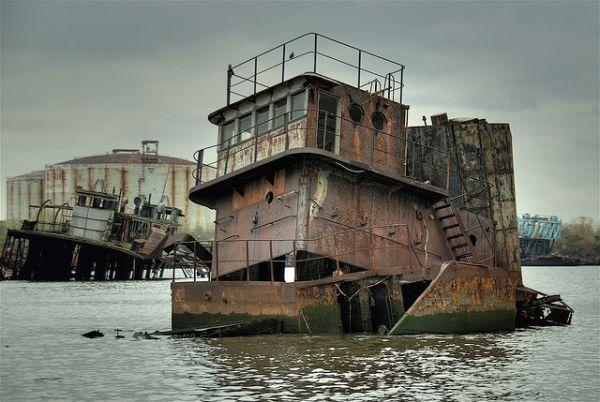

Vessels from all decades of the 20th Century lie in a state of decomposition and rust at this scrapyard at Arthur Kill Road and Rossville Avenue. Some of these craft have tales as gripping as the metropolis of Manhattan itself. The junkyard is home to one of the largest collections of historic boats in the United States and has attracted a deluge of maritime historians from across the country. Over 400 ships inhabit the yard, now known as the Don John Iron and Metal Scrap Processing Facility.


A change in environmental law mandated that these eco-systems be untouched and the hulks endured. Arthur Witte intentionally stored the vast collection of ships for parts, but the wrecks became a habitat to teeming colonies of underwater fauna. Once described by the New York Times as an accidental marine museum,” the Witte Marine Scrap Yard accumulated far more vessels than it could dismember, and the boats quickly piled up. It is located at about Arthur Kill Road and Rossville Avenue in the formerly dying town of Rossville, which has since been revitalized by acre upon acre of cookie cutter tract housing.įounded in the 1950s by Arthur Witte Jr., the yard sits on a desolate stretch of land at the junction of Arthur Kill Road and Rossville Avenue. Just before I left, I saw a rubber raft with an outboard motor puttering among the ships, and then a shiny red tugboat streamed past, its fresh white wake splashing up against the rusted shells of its ancestors.I have been a frequent visitor to what I call The Dead Pool, a bend in the Arthur Kill, the waterway separating the west and south of Staten Island from New Jersey. Apparently that’s part of the reason the ships are here: so they can continue to serve the public, if not by ferrying goods and people, by offering a brass fitting or an old tiller wheel. “Hey Mike, see that? A brass valve, right on the front!” They stood beside me for a moment, assessing the wreckage, before we were both chased off by a firm if somewhat lackadaisical guard. As I was admiring close up the sunset patterns the rust made on the hulls, a pickup truck ground up beside me and two guys hopped out. Gears, pulleys, and capstans clung to the decks of the ferryboats, tugboats, barges, and fishing boats like desperate sailors on a stormy sea, only the waters here were so stagnant that I spotted a few mussel colonies growing in the shallows.įor a different view, I drove a few yards down the road to the official entrance of the salvage yard and managed to snap a few pictures. In some places the hulls were paper thin, almost lacy, and the metal curled at the edges one could imagine it rustling and tinkling in the wind. Splintered wooden wheelhouses toppled onto decks, where crusty cleats held limp bowlines strewn with algae. Their hulls canted to port and starboard portholes pointed toward the sky. In the rippling water, Canadian geese drifted between empty shells of ships sunk in the mud. In the distance, spring birds twittered over the rush of the West Shore Expressway. The air smelled like sulfur and stagnant mud. And just ahead, through a sweep of tall grass, was what I had come to visit: the rusted hulks of ancient ships that have, like Blazing Star’s occupants and the trash of the five boroughs, also come to Rossville for their final rest: at Staten Island’s boat graveyard, otherwise known as Donjon Marine Company salvage yard.Īfter donning tall rubber boots, I pushed my way through the grasses, teetering across landfill sludge-Santa hats, flyswatters, shampoo bottles-on ancient ship beams studded with nine-inch rusty nails. Not half a mile in the distance lurked the bald green pate of Fresh Kills landfill. From the gravel shoulder where I parked, a flight of stone steps led up to the Blazing Star Burial Ground, a hillside knoll where lilacs droop over gravestones dating back to the 1700s. On a hazy day in early spring, I made my way down a shabby stretch of Arthur Kill Road on the western shore of Staten Island, past Big Nose Kate’s Saloon, Guy’s Tire Buys, and Crazy Goat Feeds pet-food store. Sense & The City’s Top 29 Cool Things to Do in New York.All the Voices: Our Political Family Trees.A Reverence for Words: Understanding Muslim Cultures through the Arts.The 369th Regiment Harlem Hellfighter’s Marching Band.Cultural Ambassadors and the Creative Traditions Network.


 0 kommentar(er)
0 kommentar(er)
